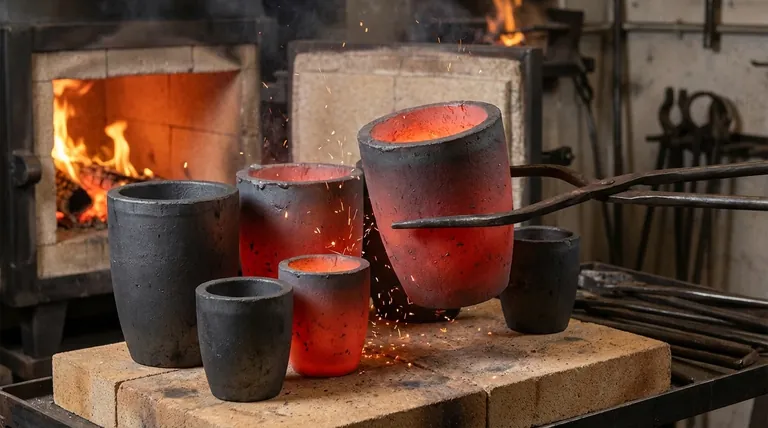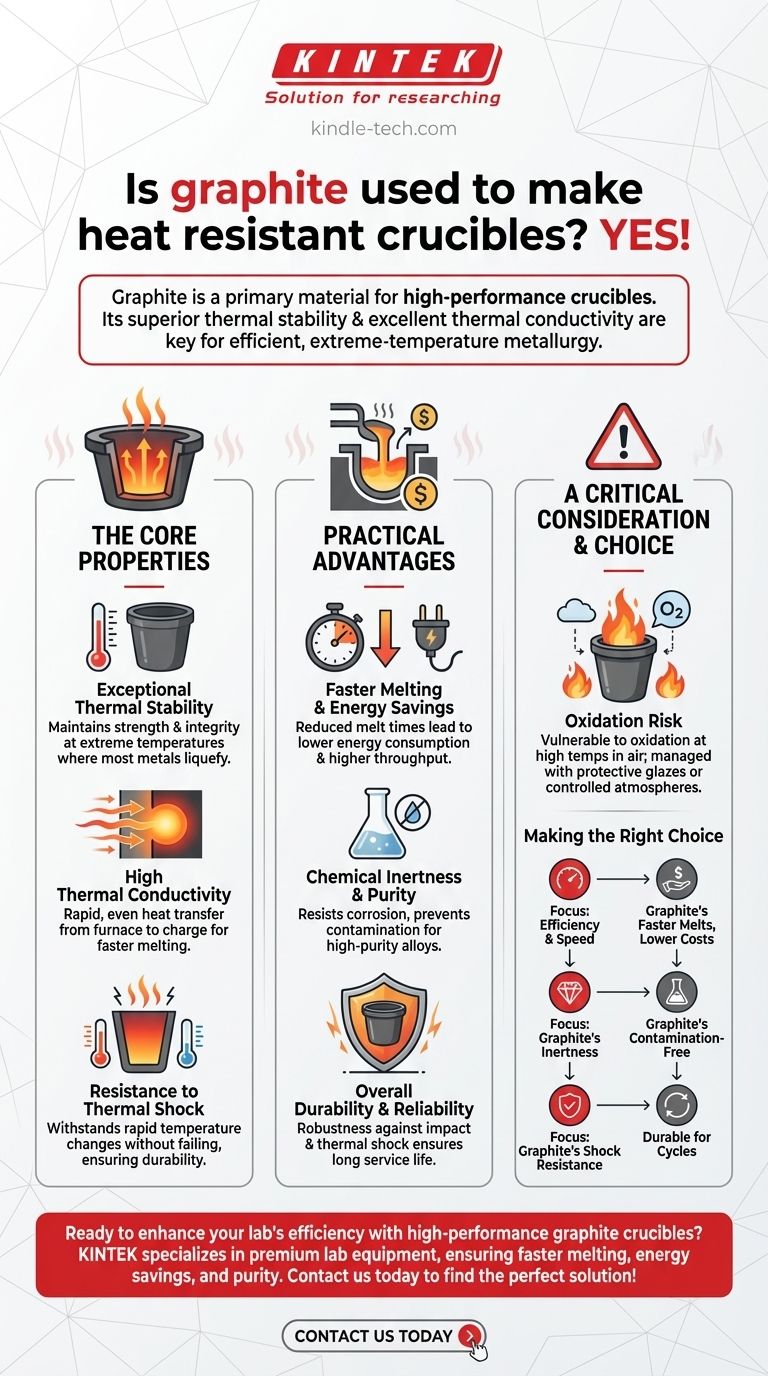Yes, graphite is a primary material used to manufacture high-performance, heat-resistant crucibles. Its unique combination of properties makes it exceptionally well-suited for high-temperature applications, particularly the smelting and casting of metals like steel and other nonferrous alloys. Graphite's ability to maintain its structural integrity at extreme temperatures is fundamental to its role in metallurgy.
The core reason for using graphite is not just its resistance to heat, but its superior thermal stability combined with excellent thermal conductivity. This allows it to both withstand extreme temperatures and efficiently transfer heat to the material being melted, saving time and energy.

The Core Properties of Graphite Crucibles
To understand why graphite is the material of choice, we need to look beyond simple heat resistance and examine the specific physical properties that make it so effective in a foundry or lab setting.
Exceptional Thermal Stability
Graphite has an extremely high melting point and maintains its strength at temperatures where most metals would have already liquefied. This core property of thermal stability ensures the crucible does not deform, melt, or fail during the demanding process of smelting metal alloys.
High Thermal Conductivity
Unlike many other heat-resistant materials (like ceramics), graphite is an excellent thermal conductor. This is a critical advantage. It means heat from the furnace is transferred through the crucible walls and into the metal charge quickly and evenly, significantly shortening the time required to reach melting temperature.
Resistance to Thermal Shock
The ability to withstand rapid temperature changes without cracking is known as thermal shock resistance. Graphite excels in this area, making it reliable for conditions involving rapid heating or the introduction of cold materials into a hot environment. This durability ensures a longer service life and greater operational safety.
Understanding the Practical Advantages
These inherent properties translate directly into tangible benefits for any process involving molten materials.
Faster Melting and Energy Savings
The high thermal conductivity is not just a technical detail—it has a direct impact on the bottom line. By reducing the time it takes to melt a charge, graphite crucibles directly contribute to lower energy consumption and higher throughput.
Chemical Inertness and Purity
Graphite demonstrates strong resistance to corrosion from acids and alkalis. More importantly, it is chemically inert in contact with most molten metals. This prevents the crucible material from reacting with and contaminating the alloy, ensuring the final product meets its required purity and quality standards.
Overall Durability and Reliability
The combination of impact resistance and resistance to thermal shock makes graphite crucibles robust and dependable. This reliability is crucial in industrial environments where equipment failure can be both costly and dangerous.
A Critical Consideration: Oxidation
While graphite performs exceptionally well, its primary vulnerability is oxidation at very high temperatures in the presence of air. In an oxygen-rich atmosphere, graphite will begin to "burn off" or degrade, which can reduce its lifespan. This is often managed through protective glazes or by controlling the furnace atmosphere.
Making the Right Choice for Your Goal
Understanding these traits allows you to select materials based on your primary objective.
- If your primary focus is efficiency and speed: Graphite's high thermal conductivity is its most valuable asset, enabling faster melt times and reducing energy costs.
- If your primary focus is alloy purity: The chemical inertness of graphite ensures that the crucible will not contaminate your molten metal.
- If your primary focus is operational reliability: Graphite's superior resistance to thermal shock makes it a durable choice for repeated, demanding heating and cooling cycles.
Ultimately, graphite provides a unique and powerful combination of thermal performance and material stability, making it the standard for many high-temperature applications.
Summary Table:
| Property | Benefit for Crucibles |
|---|---|
| High Thermal Conductivity | Faster melting times and energy savings |
| Chemical Inertness | Prevents contamination of molten metals |
| Excellent Thermal Shock Resistance | Durability under rapid temperature changes |
| Exceptional Thermal Stability | Maintains integrity at extreme temperatures |
Ready to enhance your lab's efficiency with high-performance graphite crucibles? KINTEK specializes in premium lab equipment and consumables, including durable graphite crucibles designed for superior thermal performance and longevity. Our products ensure faster melting, energy savings, and contamination-free results for your metallurgy and research applications. Contact us today to find the perfect solution for your high-temperature needs!
Visual Guide

Related Products
- Arc-Shaped Alumina Ceramic Crucible High Temperature Resistant for Engineering Advanced Fine Ceramics
- Engineering Advanced Fine Ceramics Alumina Crucibles (Al2O3) for Thermal Analysis TGA DTA
- Alumina Al2O3 Ceramic Crucible Semicircle Boat with Lid for Engineering Advanced Fine Ceramics
- Engineering Advanced Fine Alumina Al2O3 Ceramic Crucible for Laboratory Muffle Furnace
- Custom Machined and Molded PTFE Teflon Parts Manufacturer with PTFE Crucible and Lid
People Also Ask
- What is a crucible material for a furnace? A Guide to Choosing the Right High-Temperature Container
- How is a crucible used in the crucible? Unpacking Arthur Miller's Powerful Metaphor
- What temperature can alumina crucible withstand? A Guide to High-Temperature Stability and Safety
- How much heat can a ceramic crucible withstand? A Guide to Material-Specific Temperature Limits
- What is the highest temperature in a crucible? Choose the Right Material for Your High-Temp Application



















